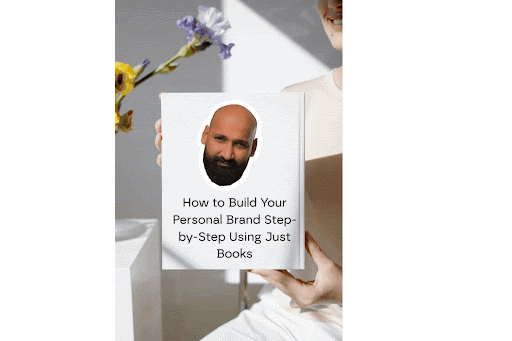There are two ways to do it. Either you pick a book that is lengthy but fruitful and valuable. So, you can follow its path and slowly but steadily work on building your personal brand. All you need is to pick the right book. A personal branding book that covers it all. The second way is a bit long; you need to define the path, and for each element and aspect of your personal branding, you will have to pick a book that is a goldmine on that particular aspect. If you ask me, I would say either of the ways is fine and perfect. Since we are talking about building a personal brand, it’s okay to surrender to its demand of effort, knowledge, and time.
Now, you must be thinking I already gave you the answer, so what is the whole blog about? The number one reason for us to craft this blog is because of our new personal branding ebook called “Become Someone From No One.” It was created by the efforts of both Bhavik Sarkhedi and Sahil Gandhi. Together we own a Webflow agency, Blushush, located in London and catering to clients all over the world. Well, we have defined a structure for you too, and we will give you names for the books that you can pick for each of these stages. Yes, by leveraging the knowledge, strategies, and insights found in books, you can craft a personal brand that reverberates with your audience and aligns with your goals. This Practical guide for Personal branding will help you in going deep on the journey of justifying how to use books as your primary tool to build a compelling personal brand, from defining your identity to sharing your expertise. Whether you're an entrepreneur, professional, or creative, this approach is accessible, cost-effective, and deeply enriching.
Let’s focus on the steps and unravel one book for each of the stages -
Step 1: Defining Core Identity
I know, we have been through this a lot of times, but you must accept the fact that every planning starts with this stage only. Before you move out into the market and navigate through other elements of personal branding, to stand out as an entrepreneur you need to assess and take a strong hold of your own personal brand core identity.
The idea is simple: if you don’t know what you are, then what is the point of all this? What are you selling? What are you pitching? What are you attracting the audience for? Here you can start with two books. One is “Start With Why” by Simon Sinek, and the other is “Designing Brand Identity: An Essential Guide for the Whole Branding Team” by Alina Wheeler. Both the books will open new avenues for you from the understanding of personal branding. These books guide you to define your core identity, which is the bedrock of your personal brand. Ask yourself: What values do I want my brand to reflect? What problems am I passionate about solving? By grounding your brand in authenticity, you create a narrative that feels genuine and compelling.
Step 2: Understand Your Audience
This is again to build a personal brand; one of your fundamental responsibilities is to derive the right target audience that you need to pitch to and attract towards your brand. To do this, you need to understand their needs, challenges, and aspirations. Books like Made to Stick by Chip and Dan Heath offer insights into crafting messages that resonate and stick with people. The Heath brothers explore why certain ideas capture attention, which can help you tailor your brand’s messaging. Similarly, Influence: The Psychology of Persuasion by Robert Cialdini provides a deep dive into human behavior, teaching you how to appeal to your audience’s motivations. As you read, take notes on how to frame your expertise in a way that addresses your audience’s pain points. You can start with any book; just remember not to blow this out of proportion by just understanding and not taking any actions.
Step 3: Build Expertise Through Deep Learning
Okay, so when you are working on a brand or brand identity, you are in pursuit of putting a dent in your end of the marketing and branding domain. This dent is a positive mark of your effort. But to make this dent, you need tools and techniques. You can only acquire them by developing a keen sense of branding knowledge and expertise with well-equipped skills and deep learning of how things work for a brand in the real market. If you’re building a brand as a marketer, read “This Is Marketing” by Seth Godin to learn how to create value-driven campaigns.
Gain your expertise through reading. Pair it with Contagious by Jonah Berger to understand why ideas spread. Take notes and apply concepts to your work, whether through small projects or thought experiments. This process not only builds expertise but also gives you content to share, reinforcing your brand’s authority.
Step 4: Develop a Unique Voice
Messaging is important; you must have a clear understanding of what you want to say, but there is one thing more important than that, and that is how you say it. This comes from developing a unique brand voice. A distinct voice that sets you apart. Books on writing and communication can help you refine how you express yourself. On Writing Well by William Zinsser is a masterclass in clear, engaging writing, teaching you how to convey ideas with clarity and personality. Similarly, Steal Like an Artist by Austin Kleon encourages you to draw inspiration from others while crafting your unique style.
As someone making constant endeavors in the direction of personal branding, you can lose it all if you do not communicate and spread your message in the right manner and tone.
Step 5: Create a Content Strategy
Maybe this step should have been the very first step. But of course branding has a huge scope, and every brand can deal with it in their own manner. Incorporate SEO for personal branding. The reason I say this is because every brand needs a content strategy. If you think your brand has no content strategy, let me inform you, you already have a troubling and no-good content strategy. You need to plan your content. Content that goes everywhere from your website and newsletters to your social media profiles.
Content Inc. by Joe Pulizzi offers a blueprint for building an audience through consistent, valuable content. Pulizzi emphasizes starting small, such as writing articles based on your expertise. Combine this with Show Your Work! by Austin Kleon, which encourages sharing your creative process to build a following.
Sharing your knowledge is critical to building a personal brand, and books can guide you in creating compelling content. Have a proper brand checklist well prepared for you.
Step 6: Build Network Through Ideas
When you build a network, you are basically connecting with more and more people. Most people think that a growing network is just adding people on LinkedIn or increasing followers. But it's not. To grow your network, you have to show value and reflect interest in others’s work as well. This is, of course, an art, and you need to master it as a skill. For this, look for books like Never Eat Alone by Keith Ferrazzi, which offers strategies for building meaningful relationships by adding value to others. Ferrazzi’s approach, sharing knowledge generously, can be applied by discussing book insights with peers or online communities. Another good example is after reading Thinking, Fast and Slow by Daniel Kahneman, you could share a post about decision-making in your industry, sparking conversations. Lastly, The Tipping Point by Malcolm Gladwell explains how ideas spread through connectors and influencers. Identify thought leaders in your niche and engage with them by referencing books you’ve both read.
Step 7: Refine Your Visual Identity
This is what we often suggest is the brand owner’s fantasy. Most entrepreneurs often think that branding is only related to creating a good visual identity. This is where their creative juices start to flow. They think about the color, the logo, the font, the imagery, and everything, but they forget that it all is a part of a psychological element that they have to grasp from good branding books.
The Non-Designer’s Design Book by Robin Williams is an accessible guide to design principles like contrast, repetition, and alignment. Use these principles to create a consistent look for your blog, social media, or business cards, even if you’re not a designer. The second book to combine this is Slide:ology by Nancy Duarte to learn how to present your ideas visually, whether in presentations or social media graphics. These books teach you to create a polished, professional image that complements your intellectual brand, ensuring every touchpoint feels cohesive.
Conclusion
At last, of course, there are many other self-development books that you can seek motivation, knowledge, and tips from, but we would only like to mention that we have crafted a new personal branding ebook that you can read and make the most of. Both Bhavik Sarkhedi and I (Sahil Gandhi) have put all our efforts and time into this, and we strongly believe that if you are planning to build a personal brand, this book can be your one-stop solution. Start with this one book, apply its lessons, and build momentum. Over time, your brand will reflect the depth of your learning and the strength of your unique perspective, proving that a bookshelf can be your most powerful branding tool. Download the Personal Branding Gold Mine eBook and start your journey of becoming someone from no one.



